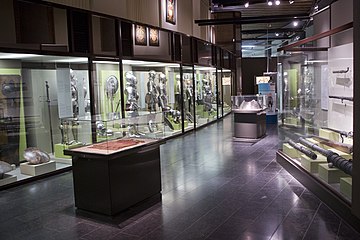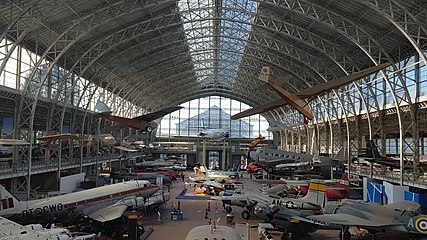Royal Museum of the Armed Forces and Military History
This article needs additional citations for verification. (December 2023) |
| Nearest car park | Museum grounds |
|---|---|
| Website | Official website |
The Royal Museum of the Armed Forces and Military History (
.History
Origins (c. 1880–1910)
The Parc du Cinquantenaire/Jubelpark was part of a project commissioned by the Belgian Government under the patronage of King Leopold II for the 1880 National Exhibition, commemorating the 50th anniversary of the Belgian Revolution.[3] In 1875, the architect Gédéon Bordiau made a proposal to build on this site, part of the so-called "Linthout" plains, the former military exercise ground of the Garde Civique outside of Brussels' city centre. The location was named Cinquantenaire in French (literally "Fiftieth Anniversary") and Jubelpark in Dutch ("Jubilee Park") because it was planned as an exhibition space to celebrate the anniversary.[1]

Temporary structures were erected on the site for the
Development of the museum
The museum was created by virtue of a
After the death of Albert I in 1934, the museum also took possession of part of the north pavilion of 1880, where the collection of casts of the future Royal Museums of Art and History (RMAH) had been established since 1886. On 9 April 1935, King Leopold III inaugurated a room there dedicated to his father and World War I. After 1945, the museum appropriated the entire pavilion; a section dedicated to Leopold III and World War II is set up there, inaugurated on 10 May 1955 by King Baudouin. Two years earlier, the institution had taken the official name of the Royal Museum of the Army and Military History (French: Musée Royal de l'Armée et d'Histoire Militaire or MRA, Dutch: Koninklijk Museum van het Leger en de Krijgsgeschiedenis or KLM).[5]
A fire destroyed the south wing of the complex in 1946, part of the Royal Museums of Art and History (RMAH).[5] The collection pieces were saved, and the burnt wing has since been rebuilt. As for the north wing, home to the Royal Museum of the Armed Forces and Military History, it was spared.
The building

The museum occupies the two northernmost halls of the Cinquantenaire: the northern Bordiau wing and the North Hall. Completed for the 1880 exhibition, like its southern counterpart, destroyed by fire in 1946 (and since rebuilt), the North Hall is the oldest building in the complex. Constructed in stone and metal, it combines classical rigor and industrial innovation in an original way.
The building has a rectangular plan, marked at each corner by a projection. Set in a masonry structure, its imposing iron frame forms a single-span structure composed of eight vast arches. These are supported on the side facades by cast iron buttresses with arcades on masonry buttresses. They are composed of two curved beams connected by means of metal parts forming a trellis, a motif that is found in other metal constructions of Bordiau. At the top of the roof is a saddleback skylight of which only the thin vertical walls are glazed.[5]
Collection
The museum's collection originally consisted of approximately 900 pieces collected by the officer Louis Leconte following World War I.[5] Leconte collected considerable equipment abandoned by the Germans in 1918. The collection was later heavily enriched by legacies, gifts and exchanges.
Important developments in the 20th century included the opening of three new Departments of Technology, Scientific Documentation and Research in 1976, followed by the armoured vehicle section in 1980, the move of the armours collection from the Halle Gate to the northernmost hall in 1986, and the opening of the naval section in 1996.[5]
Nowadays, the museum displays uniforms, weapons, vehicles and military equipment of all ages and all countries. Since 2004, the European Forum on Contemporary Conflicts has also had its headquarters in the museum.
Middle Ages
The medieval collection presents an overview of the period's offensive and defensive armament, and consists of an extensive display of weapons, shields, and banners, from the simple
-
View of the medieval collection
-
Historic armours
19th century
The main gallery is dedicated to Belgian military history from 1830 to the eve of World War I, along with paintings and busts of important military figures of the time. The technical gallery is where the evolution of firearms and manufacturing processes is shown. Several of the Belgian Army's weapons, especially portable ones, since its creation, are on display.
-
Main gallery, with the collection of Belgian 19th-century militaria
-
Belgian and French warships during theRio Nuñez Incident, Paul Jean Clays, c. 1850
-
Portrait of Guillaume Delcourt, Louis Joseph Ghémar, 1854[6]
-
A part of the collection of historic medals
World War I
This section showcases a large concentration of uniforms, artillery pieces and vehicles. The planes of this war are exposed in the room dedicated to aviation. In this room is a
-
Lodestar III Mark IV tank
-
Firefly Medium Mark A Whippet tank
-
Renault FT-17 tank
Aviation
The north wing, built by Gédéon Bordiau, has been occupied by the Aviation Hall since 1972, when the Air and Space gallery was inaugurated.[citation needed] The collection includes various types of aircraft, both military and civilian, some dating back to the early 20th century. It includes surviving WWI aircraft like the Nieuport 17 and Sopwith Camel, whilst the most recent additions include an F-16 Fighting Falcon and Westland Sea King. The collection as a whole is one of the largest in the world.[7]
-
View of the aviation section in the North Hall
-
Aviation collection
-
Battaille triplane (1911)
Dedicated to the
-
P903 Meuse patrol boat (1953)
-
Tucker Sno-Cat, part of the Antarctica collection
Armoured vehicles
Several of the armoured vehicles that the museum holds are in rooms dedicated to WWI and WWII. Displayed in this courtyard are, among others, an M24 Chaffee, an M41 Walker Bulldog, as well as various Leopard 1 models. One of them is equipped with equipment for deep wading.
-
M46 Patton tank (1952) in the outdoor collection
-
Belgian 1970s'Paracommandodiorama
See also
- AutoWorld
- List of museums in Brussels
- History of Brussels
- Culture of Belgium
- Belgium in the long nineteenth century
References
Citations
- ^ a b "The history of the museum". Klm-mra.be. Archived from the original on 3 June 2013. Retrieved 25 March 2013.
- Away.com.
- ^ a b Région de Bruxelles-Capitale (2009–2010). "Arcade et hémicycle" (in French). Brussels. Retrieved 9 June 2022.
- ^ Schroeder-Gudehus & Rasmussen 1992, p. 128–131.
- ^ a b c d e f "Musée de l'Armée et d'Histoire militaire – Inventaire du patrimoine architectural". monument.heritage.brussels (in French). Retrieved 18 June 2022.
- ^ Leconte 1952, p. 186.
- ^ Palix 1982, p. 58–63.
Bibliography
- Leconte, Louis (1952). Les ancêtres de notre Force Navale (in French). Brussels: Etablissements Pauwels Fils.
- Palix, Didier (1982). "Les avions du musée de l'armée à Bruxelles". Connaissance de l'Histoire (in French). 46. Hachette.
- Schroeder-Gudehus, Brigitte; Rasmussen, Anne (1992). Les fastes du progrès : le guide des expositions universelles 1851-1992 (in French). Paris: Flammarion. ISBN 978-2-08-012617-7.
External links
 Media related to Royal Military Museum, Brussels at Wikimedia Commons
Media related to Royal Military Museum, Brussels at Wikimedia Commons- Official website
- Photo Tour of the Aviation Hall
- Brussels Air Museum
- Brussels Air Museum Restoration Society
- Brussels Air Museum Fund






![Portrait of Guillaume Delcourt, Louis Joseph Ghémar, 1854[6]](http://upload.wikimedia.org/wikipedia/commons/thumb/a/a1/Guillaume_Delcourt_Portrait.png/205px-Guillaume_Delcourt_Portrait.png)










